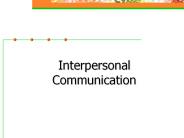Interpersonal Processes: Aggression - PowerPoint PPT Presentation
1 / 12
Title:
Interpersonal Processes: Aggression
Description:
'Aggression is a response that delivers noxious stimuli to another organism' (Buss, 1961, p. 1) ... Instrumental or Specific Aggression: Concerned with ... – PowerPoint PPT presentation
Number of Views:133
Avg rating:3.0/5.0
Title: Interpersonal Processes: Aggression
1
Interpersonal ProcessesAggression
- Political Psychology
2
Definition of Aggression
- Aggression is a response that delivers noxious
stimuli to another organism (Buss, 1961, p. 1) - intent to harm
- motivation of the victim
- form of aggression
3
Four Categories of Aggression
- Instrumental or Specific Aggression Concerned
with obtaining or retaining particular objects or
positions or access to desirable activities. - Hostile or Teasing Aggression Directed towards
annoying or injuring another individual. - Defensive or Reactive Aggression Provoked by the
actions of others. - Games Aggression Involving deliberate attempts
to inflict injury escalating out of physical
games.
4
Origins and Antecedents of Aggression.
- Konrad Lorenz
- The Frustration-Aggression Hypothesis
- Research on Brain Stimulation
- Sigmund Freud
- Genetics
- The Media
5
Konrad Lorenz
- There can not be any doubt, in the opinion of
any biologically minded scientist, that
intra-psychic aggression is, in man, just as much
of a spontaneous instinctive drive as in most
other higher vertebrates. (1964, pp. 49) - the fighting instinct in beast and man
- Huntingford, F. A. (1989). Animals fight, but do
not make war. In J. Grobel and R. A. Hinde
(Eds.). Aggression and War Their Biological and
Social Bases. NY Cambridge University Press.
6
Frustration-Aggression Hypothesis
- Dollard, J., Doob, L. W., Miller, N. E., Mowrer,
O. H., Sears, R. R. (1939). Frustration and
Aggression. New Haven, CT Yale University Press.
7
Research on Brain Stimulation
- Eichelman, B. (1971). Effects of subcortical
lesions on shock-induced aggression in the rat.
Journal of Comparative and Physiological
Psychology, 74, 331-9. - Delgado, J. M. R. (1969). Physical Control of the
Mind. New York Harper Row.
8
Genetics
Table 1. Correlates of twin type with personality
variables
Rushton, J. P. et al. (1986). Altruism and
Aggression The heritability of individual
differences. Journal of Personality and Social
Psychology, 50, 1192-8
Carmelli, D. et al (1990). The Heritability of
the Cook and Medley Hostility Scale Revisited.
Journal of Social Behaviour and Personality, 5,
107-16.
9
Lombroso XYY Males
- Once the idea was accepted that inherited genetic
traits might be related to aggression,
researchers hoped to isolate the specific genes
involved. The chemical packages that comprise
genes are known as chromosomes. Every human cell
contains 23 pairs of chromosomes that contain
DNA. Each person has two sex chromosomes, males
XY and females XX. - The first finding made by scientists of an
abnormal chromosome pattern that was believed
might be related to 'hyper-aggressiveness' was
the XYY chromosome, characterized by the extra
male Y chromosome. It was hypothesized that the
extra Y chromosome resulted in a "supermale," one
who was therefore more predisposed to aggressive
and violent behavior. Research had found 3 of
men in maximum security prisons were XYY while
only 0.1 of the general population was XYY. - Led to calls for compulsory sterilization,
segregation, lobotomies and even euthanasia
against the "unfit." - However, contrary to expectation, studies of XYY
populations within prisons found them
considerably less violent than their non-XYY
counterparts. - Explanations for the relatively high
institutionalization rates for XYY males include
fear of their physical height, slightly lower IQ
scores, although evidence for the later is quite
weak.
- Lombroso popularized the notion of a born
criminal through biological determinism.
Criminals have particular physiognomic attributes
or deformities. Physiognomy attempts to estimate
character and personality traits from physical
features of the face or the body. Whereas most
individuals evolve, the violent criminal had
devolved, and therefore were societal, or
evolutionary regressions. If criminality was
inherited, then the born criminal could be
distinguished by physical atavistic stigmata,
such as - large jaws, forward projection of jaw, Low
sloping forehead - high cheekbones, flattened or upturned nose
- handle-shaped ears
- hawk-like noses or fleshy lips.
- Hard Shifty eyes, scanty beard or baldness
- Insensitivity to pain, long arms.
10
Sigmund Freud
- Freud, S. Why War Standard Edition of Complete
Works, Vol 22. (Ed.) J. Strachey, London
Hogarth. - Life instinct (eros)
- Death Instinct (thanatos).
11
Media Influences
- Lead to a Set of Beliefs about Aggression
- Humans are instinctively aggressive. Therefore an
outlet for this destructive expression must be
found. - Failure to express anger results in heart
disease, stress and high blood pressure.
Expressing anger is a health way to deal with it. - Substitute activities, such as football and
watching violent films can control our aggressive
urges. - Children should be allowed to play aggressively.
This will get it out of their system and they
will be better behaved as a result. - Extreme acts of violence, such as terrorism and
child abuse, are usually committed by mentally
ill individuals. - Violence is a result of aggressive drives. In
some individuals and groups this motive is
abnormally strong. - War is an expression of the aggressive instinct.
It is unavoidable because humans have an inborn
need to satisfy their aggressive urges. Peace is
only a temporary period between wars.
12
Conclusion
- We are biological creatures
- We can change ourselves and adapt
- We are not in a vacuum
- Assumptions shape our choices
- Warfare is complex
- The biological template has its
- limitations




























